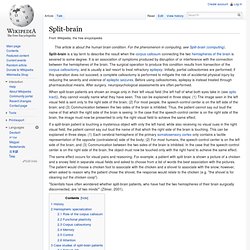

Sperry's 'Split-Brain' studies and multiple streams of consciousness. Early Split Brain Research Gazzaniga - Video - IB Psychology 2013 & IB ToK 2012. Split-brain Study. Split- Brain Behavior. Biology 202 2000 First Web Report On Serendip Maria Vasiliadis Of all the syndromes in neurology and of all the discoveries in brain research, none is more wondrous than the behavior of a split-brain human patient.

Everytime split-brain patients are examined, they reveal truths about how brain enables mind. Split-brain effects have to be exposed in a laboratory, where special techniques separately test each half-brain. >From such tests we can discover the amazing effects of disconnection. We are aware that different parts of the brain are specialized to perform different functions. Surgeons treat some cases of epilepsy, when no other options are available, by cutting the corpus callosum, which connects the two cerebral hemispheres. The unusual behavior of the split brain patient has revealed many differences between the two brain hemispheres. Research was also done at the McLean Hospital by Fredric Schiffer MD, who studied two split brain patients. WWW Sources. The split brain: A tale of two halves. In the first months after her surgery, shopping for groceries was infuriating.

Standing in the supermarket aisle, Vicki would look at an item on the shelf and know that she wanted to place it in her trolley — but she couldn't. “I'd reach with my right for the thing I wanted, but the left would come in and they'd kind of fight,” she says. “Almost like repelling magnets.” Picking out food for the week was a two-, sometimes three-hour ordeal.
Getting dressed posed a similar challenge: Vicki couldn't reconcile what she wanted to put on with what her hands were doing. In one crucial way, however, Vicki was better than her pre-surgery self. In June 1979, in a procedure that lasted nearly 10 hours, doctors created a firebreak to contain Vicki's seizures by slicing through her corpus callosum, the bundle of neuronal fibres connecting the two sides of her brain. After about a year, Vicki's difficulties abated. Nature Podcast Michael Gazzaniga reflects on five decades of split-brain research No. The Split Brain Experiments. Background In the 19th century, research on people with certain brain injuries, made it possible to suspect that the "language center" in the brain was commonly situated in the left hemisphere.

One had observed that people with lesions in two specific areas on the left hemisphere lost their ability to talk, for example. The final evidence for this, however, came from the famous studies carried out in the 1960s by Roger Sperry and his colleagues. The results of these studies later led to Roger Sperry being awarded the Nobel Prize in Physiology or Medicine in 1981. Sperry received the prize for his discoveries concerning the functional specialization of the cerebral hemispheres.
What Does "Split Brain" Mean? In the 1960s, there was no other cure for people who suffered from a special kind of epilepsy than by cutting off the connection, corpus callosum, between the two hemispheres. What Came Out of the Split Brain Experiments? Roger Sperry. Split-brain. Split-brain is a lay term to describe the result when the corpus callosum connecting the two hemispheres of the brain is severed to some degree.

It is an association of symptoms produced by disruption of or interference with the connection between the hemispheres of the brain. The surgical operation to produce this condition results from transection of the corpus callosotomy, and is usually a last resort to treat refractory epilepsy. Initially, partial callosotomies are performed; if this operation does not succeed, a complete callosotomy is performed to mitigate the risk of accidental physical injury by reducing the severity and violence of epileptic seizures. Before using callosotomies, epilepsy is instead treated through pharmaceutical means. After surgery, neuropsychological assessments are often performed. The same effect occurs for visual pairs and reasoning. History[edit] The modern era of split-brain research began in the late 1950s. Hemispheric specialization[edit] Memory[edit]